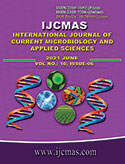


 National Academy of Agricultural Sciences (NAAS)
National Academy of Agricultural Sciences (NAAS)

|
PRINT ISSN : 2319-7692
Online ISSN : 2319-7706 Issues : 12 per year Publisher : Excellent Publishers Email : editorijcmas@gmail.com / submit@ijcmas.com Editor-in-chief: Dr.M.Prakash Index Copernicus ICV 2018: 95.39 NAAS RATING 2020: 5.38 |
The aim of this study was to determine the comparative histomorphological changes of bovine Foot and Mouth Disease (FMD) at different clinical stages in clinically some infected and non-infected diseased cattle. The disease was characterized by fever and vesicular eruption in the mouth, nares, muzzle, foot, teats and other hairless soft areas of the body and morphologically moderate raised values (p≤0.05) were recorded in rectal temperature, respiratory and pulse rate, where highest values were during 3 to 7 days of post infection which subsequently reduced after passing the days of infection. Microscopic changes were observed at the advanced stages in the tongue epithelium of the infected cattle, which consisted of ballooned epithelial cells of stratum spinosum showing eosinophilic cytoplasm, acantholysis, pyknotic nucleus with granulocyte infiltration and complete necrosis or dissolution of stratified squamous epithelial surface and the filiform papillae rather than the control, primary and recovery stages. These changes were progressed to microvesicle which on coalescence formed grossly visible macrovesicle (bullae). While, loss of striation of the intercalated bundles of striped muscles fibers and necrosis with intense neutrophil infiltration in the interdigital (foot) space epithelium were observed only at the recovery stages. Therefore the comparative relationship of elevated body temperature, respiratory, pulse rate with histological changes at different clinical stages in this research might be helpful for the virologists, cell-biologists, anatomists and veterinarians to plan for the better management, prevention and future control strategies of FMD.
 |
 |
 |
 |
 |